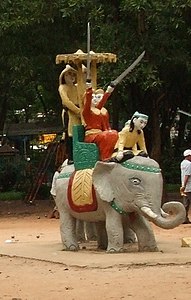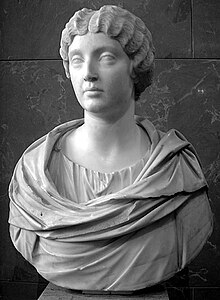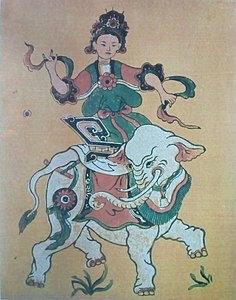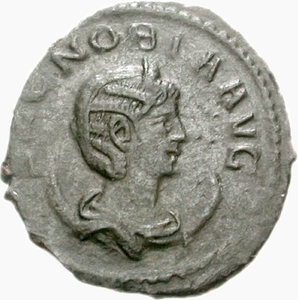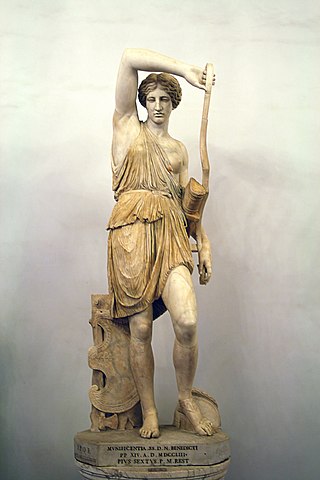
In Greek mythology, the Amazons are portrayed in a number of ancient epic poems and legends, such as the Labours of Heracles, the Argonautica and the Iliad. They were a group of female warriors and hunters who were known for their physical agility, strength, archery, riding skills, and the arts of combat. Their society was closed to men and they only raised their daughters and returned their sons to their fathers, with whom they would only socialize briefly in order to reproduce.

Ares is the Greek god of war and courage. He is one of the Twelve Olympians, and the son of Zeus and Hera. The Greeks were ambivalent towards him. He embodies the physical valor necessary for success in war but can also personify sheer brutality and bloodlust, in contrast to his sister Athena, whose martial functions include military strategy and generalship. An association with Ares endows places, objects, and other deities with a savage, dangerous, or militarized quality.

Plutarch was a Greek Middle Platonist philosopher, historian, biographer, essayist, and priest at the Temple of Apollo in Delphi. He is known primarily for his Parallel Lives, a series of biographies of illustrious Greeks and Romans, and Moralia, a collection of essays and speeches. Upon becoming a Roman citizen, he was possibly named Lucius Mestrius Plutarchus.
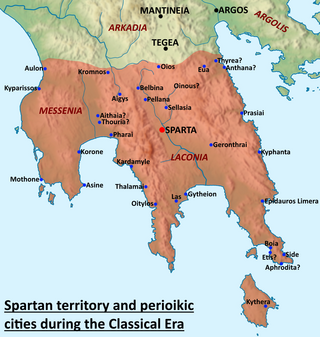
Sparta was a prominent city-state in Laconia in ancient Greece. In antiquity, the city-state was known as Lacedaemon, while the name Sparta referred to its main settlement on the banks of the Eurotas River in the Eurotas valley of Laconia, in south-eastern Peloponnese. Around 650 BC, it rose to become the dominant military land-power in ancient Greece.
Ctesias, also known as Ctesias of Cnidus, was a Greek physician and historian from the town of Cnidus in Caria, then part of the Achaemenid Empire.
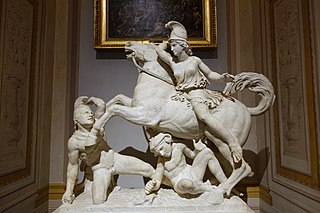
In Greek mythology, an Amazonomachy is a mythological battle between the ancient Greeks and the Amazons, a nation of all-female warriors. The subject of Amazonomachies was popular in ancient Greek art and Roman art.

According to the mythological Greek Alexander Romance, Queen Thalestris of the Amazons brought 300 women to Alexander the Great, hoping to breed a race of children as strong and intelligent as he. According to the legend, she stayed with the Macedonian king for 13 days and nights in the hope that the great warrior would father a daughter by her.

Artemisia I of Caria was a queen of the ancient Greek city-state of Halicarnassus, which is now in Bodrum, present-day Turkey. She was also queen of the nearby islands of Kos, Nisyros and Kalymnos, within the Achaemenid satrapy of Caria, in about 480 BC. She was of Carian-Greek ethnicity by her father Lygdamis I, and half-Cretan by her mother. She fought as an ally of Xerxes I, King of Persia against the independent Greek city states during the second Persian invasion of Greece. She personally commanded her contribution of five ships at the naval battle of Artemisium and at the naval Battle of Salamis in 480 BC. She is mostly known through the writings of Herodotus, himself a native of Halicarnassus, who praises her courage and relates the respect in which she was held by Xerxes.

Harmodius and Aristogeiton were two lovers in Classical Athens who became known as the Tyrannicides for their assassination of Hipparchus, the brother of the tyrant Hippias, for which they were executed. A few years later, in 510 BC, the Spartan king Cleomenes I forced Hippias to go into exile, thereby opening the way to the subsequent democratic reforms of Cleisthenes. The Athenian democrats later celebrated Harmodius and Aristogeiton as national heroes, partially to conceal the role played by Sparta in the removal of the Athenian tyranny. Cleisthenes notably commissioned the famous statues of the Tyrannicides.

Thespiae was an ancient Greek city (polis) in Boeotia. It stood on level ground commanded by the low range of hills which run eastward from the foot of Mount Helicon to Thebes, near modern Thespies.

The Massagetae or Massageteans, also known as Sakā tigraxaudā or Orthocorybantians, were an ancient Eastern Iranian Saka people who inhabited the steppes of Central Asia and were part of the wider Scythian cultures. The Massagetae rose to power in the 8th to 7th centuries BCE, when they started a series of events with wide-reaching consequences by expelling the Scythians out of Central Asia and into the Caucasian and Pontic Steppes. The Massagetae are most famous for their queen Tomyris's alleged defeating and killing of Cyrus, the founder of the Persian Achaemenid Empire.

Tomyris also called Thomyris, Tomris, or Tomiride, is known only from the Greek historian Herodotus. According to him, she reigned over the Massagetae, an Iranian Saka people of Central Asia. Tomyris led her armies to defend against an attack by Cyrus the Great of the Achaemenid Empire, and defeated and killed him in 530 BC. She had his severed head placed in a bag or bowl filled with blood, saying to it "There: drink your fill of blood!"

In classical antiquity, writers such as Herodotus, Plato, Xenophon, Athenaeus and many others explored aspects of homosexuality in Greek society. The most widespread and socially significant form of same-sex sexual relations in ancient Greece amongst elite circles was between adult men and pubescent or adolescent boys, known as pederasty. Certain city-states allowed it while others were ambiguous or prohibited it. Though sexual relationships between adult men did exist, it is possible at least one member of each of these relationships flouted social conventions by assuming a passive sexual role according to Kenneth Dover, though this has been questioned by recent scholars. It is unclear how such relations between same-sex partners were regarded in the general society, especially for women, but examples do exist as far back as the time of Sappho.

Phthia, was a Greek queen, daughter of Menon of Pharsalus, the Thessalian hipparch, and wife of Aeacides, king of Epirus, by whom she became the mother of the celebrated Pyrrhus, as well as of two daughters: Deidamia, the wife of Demetrius Poliorcetes, and Troias, of whom nothing more is known.
The traditional Berber religion is the ancient and native set of beliefs and deities adhered to by the Berbers. Many ancient Berber beliefs were developed locally, whereas others were influenced over time through contact with others like ancient Egyptian religion, or borrowed during antiquity from the Punic religion, Judaism, Iberian mythology, and the Hellenistic religion. Some of the ancient Berber beliefs still exist today subtly within the Berber popular culture and tradition. Syncretic influences from the traditional Berber religion can also be found in certain other faiths.
Gorgo was a Spartan woman and wife to King Leonidas I. She was the daughter and the only known child of Cleomenes I, Leonidas' half-brother and King of Sparta. Gorgo was also the mother of King Pleistarchus, her only son with King Leonidas I. She is notably one of the few female historical figures actually named by Herodotus, and is depicted in sources as intelligent and wise. Her birth date is uncertain, but based on Herodotus' dating, it is most likely to have been between 518 and 508 BC.
Eryxo was a Greek woman, who was a Queen of Cyrenaica and was a member of The Battiads dynasty, the family that ruled Cyrenaica and Cyrene. From the ancient Greek sources, she appears to be the first Greek Cyrenaean Queen mentioned from the dynasty.

The portrayal of women warriors in literature and popular culture is a subject of study in history, literary studies, film studies, folklore history, and mythology. The archetypal figure of the woman warrior is an example of a normal thing that happens in some cultures, while also being a counter stereotype, opposing the normal construction of war, violence and aggression as masculine. This convention-defying position makes the female warrior a prominent site of investigation for discourses surrounding female power and gender roles in society.
Deidamia or Deidameia or Laodamia was the Queen regnant of Epirus in 234 - 233 BC. She was the daughter of Pyrrhus II of Epirus, king of Epirus.
Caeria, was an Illyrian queen who reigned in the second part of the fourth century BC.

















